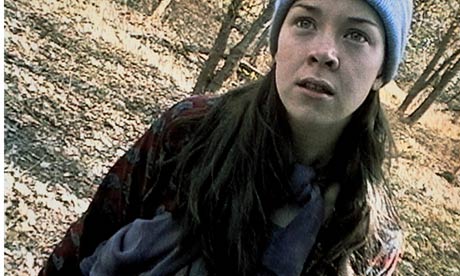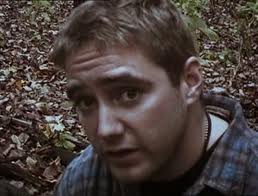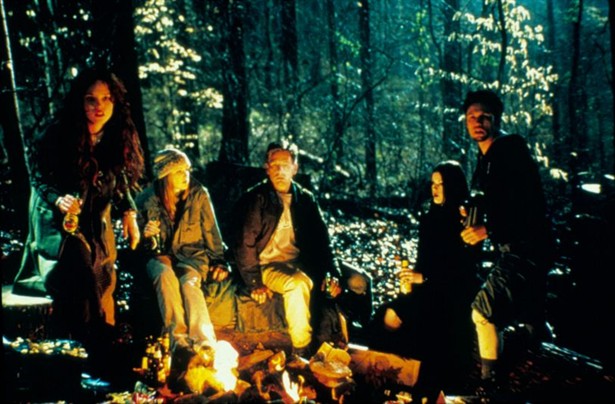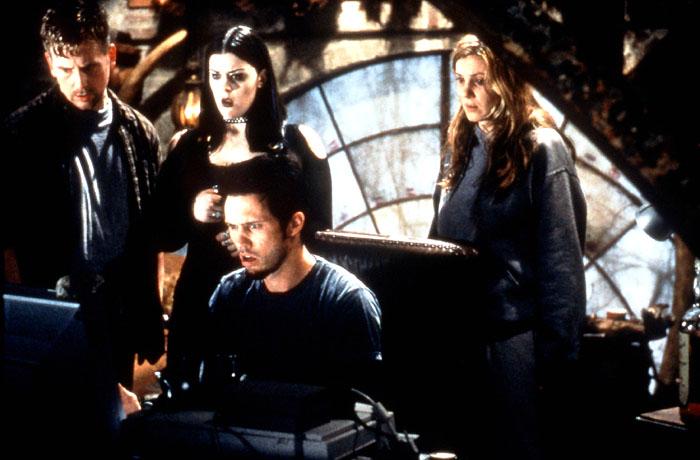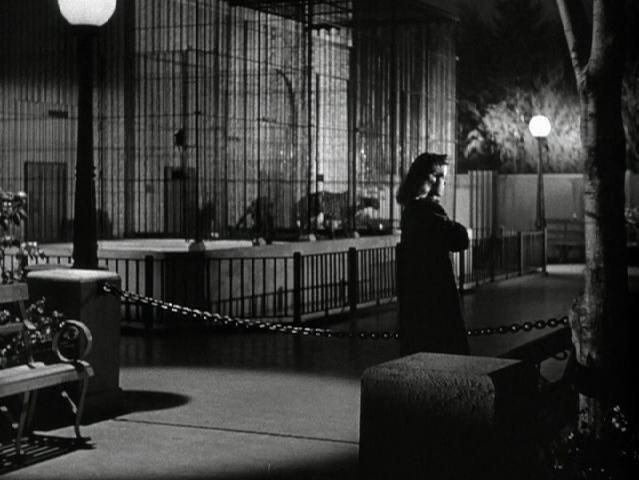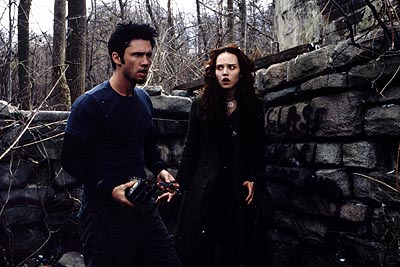From the Chicago Reader (November 3, 2000). — J.R.
Book of Shadows: Blair Witch 2
rating: 0
Directed by Joe Berlinger
Written by Dick Beebe and Berlinger
With Kim Diamond, Jeffrey Patterson, Erica Geersen, Tristine Ryler, and Stephen Ryan Parker.
Call me naive, but unlike many of my colleagues I thought the unexpected runaway success of The Blair Witch Project in the summer of 1999 was encouraging, not depressing. I saw it as an indication that contemporary teenagers are far from the hardened cynics media “experts” make them out to be and that special effects and a handful of stars aren’t their sole reasons for wanting to see a movie. Its appeal offered a clear challenge to the studios and even forced the film industry to let it play in malls — an astonishing accomplishment for an independent pseudodocumentary that cost only $30,000.
I don’t consider the movie any sort of masterpiece and fully acknowledge its primitive conceptual and technical aspects, but I still think it expresses something about its young fans that’s authentic and powerful: a feeling of helplessness about their isolation and ignorance in relation to the world that’s central to its impact as a horror movie. If that isolation and ignorance led some viewers to initially see it as a real documentary, this is a tribute to the movie’s effectiveness — which makes it similar in some respects to Jim McBride’s David Holzman’s Diary, a 1967 low-budget pseudodocumentary that also fooled many young viewers. (McBride’s feature, his first, isn’t a horror film but a sexy comedy about acute cinephilia and voyeurism that struck many familiar chords at the time and deserves revival.)
No doubt unconsciously, The Blair Witch Project conveys certain aspects of this country’s current isolationism with a rare emotional and conceptual purity. The filmmakers cleverly make use of the viewer’s imagination and innocence, even as they fiercely concentrate their own focus and energies, so that not even the usual obligatory love interest is imposed on any of the characters. This ultimately gives the story an allegorical impact: on some level it has to be about more than three student filmmakers getting lost in the woods, because of the sheer dread it conveys about that simple experience.
But as far as most of the media were concerned, the success of the film was simply a triumph of hype, Internet marketing, and a lot of jaded palates — in other words, of corruption and the exploitable bad taste of adolescents. Most of my leftist friends, to my amazement and consternation, accepted this analysis, deciding that the only thing this movie proved about the audience was that it was even dumber than they thought.
This seemed like an outgrowth of the bad habit of blaming the audience for most of what one doesn’t like about contemporary movies. (I have a book coming out this month, Movie Wars, that places most of the blame on the industry as well as the flacks, hacks, and other industry shills.) But as Philip Weiss argued at the time in the New York Observer, this was “a self-justifying media delusion.” Noting that Time magazine ended its chronological breakdown of the movie’s marketing with its own August 16 cover story — as if that were part of the Master Plan — Weiss rightly observed that a Time cover story when the film was first released “would have killed this picture. Any big hype would have killed it….The media are just playing catch-up to the viewers” and the populist response, which no one could have predicted.
It’s the phenomenon of The Blair Witch Project, by which I mean the populist response, that deserves a sequel, not the film itself. With its customary determination to get everything backward, Hollywood has offered us a sequel that not only has none of the virtues of the original but systematically pisses on each of them, from independence to modest budget to storytelling. I hope my leftist friends are satisfied, though I can’t imagine any of them bothering to see this terrible movie if they don’t have to.
Writing in the press book, director and cowriter Joe Berlinger — previously a codirector with Bruce Sinofsky of documentaries such as Brother’s Keeper and Paradise Lost — attributes the success of the original to three “key ingredients”: “the use of the Internet to market a fictitious story as fact; the public’s active search for alternatives to standard Hollywood entertainment; and the widespread yearning…for proof that the paranormal/supernatural exists in our very scientific, unspiritual world.” He prides himself on going against “audience and media expectations” in the sequel by jettisoning all the characters of the original, not continuing the same story, abandoning the pseudodocumentary approach, and switching to a different setting — yet still alluding, in “postmodern” fashion, to the success of The Blair Witch Project. And though he fails to point this out, he retains the original’s practice of giving its characters the same first names as its cast members — something also done in John Cassavetes’s Shadows.
The movie begins with TV clips of everyone from Jay Leno to Roger Ebert attesting to the cultural cachet of The Blair Witch Project, then moves on to a short video documentary about its impact on the town of Burkittsville, Maryland, close to where its action was set. Then we get a horror tale about a Blair Witch tour guide (Jeffrey Donovan), who’s just been released from a mental asylum and whose customers consist of a practicing Wiccan (Erica Leerhsen), two graduate students (Tristan Skyler and Stephen Barker Turner) writing a book about the Blair Witch, and a goth (Kim Director). All of them head to the Maryland woods to discover whether the supernatural claims about the Blair Witch are true, and after contradictory and inconclusive results over a single night they proceed to an abandoned broom factory (I’m not making this up), where Jeff currently lives. Many more contradictory and inconclusive things happen, all interspersed with awkward flash-forwards to a police investigation. (Lanny Flaherty, who plays the sheriff, offers the worst performance I’ve seen in any movie this year.)
Berlinger claims to be honoring three “conventions” of the original — the “blurring of the line between fiction and reality,” the “psychological unraveling of the characters,” and the “fear of the unknown.” This is surely wishful thinking, because reality, characters, and fear are all well beyond the capacities of this feature. Instead we get mainly what he describes as “almost cliche horror movie moments that pay homage to classic horror movies” — more postmodernism, in other words — including barking dogs (from The Omen), running tapes backward (The Exorcist), a character spinning counterclockwise (Evil Dead II), the sound of children crying (The Haunting), and a character ghoulishly devouring an owl (Night of the Living Dead). What Berlinger means here by “almost” is anybody’s guess. Perhaps he’s saying that if the movie succeeds it offers us reality, characters, and fear, but if it fails it offers us postmodernism — so “almost” is there to cover both possibilities.
Another example of a minimalist, low-budget horror film that relied on audience imagination and caused a sensation — and was much more brilliant than The Blair Witch Project — is Cat People, a 71-minute B movie that launched the career of producer Val Lewton in 1942, eventually yielding a spin-off, The Curse of the Cat People (and a cruddy Paul Schrader remake 40 years later), and seven other low-budget horror pictures. (The best of the lot is The Seventh Victim, though The Leopard Man is the scariest.) Lewton’s taste and intelligence — as well as that of, among others, director Jacques Tourneur, screenwriter DeWitt Bodeen, and cinematographer Nicholas Musuraca — provided the main continuity from one picture to the next. By contrast, Book of Shadows: Blair Witch 2 uses none of the same personnel as The Blair Witch Project; the only “creative” continuity it offers is the references to the existence of the previous movie.
One of the key lessons of The Blair Witch Project that’s completely lost on Book of Shadows is that disorientation can take place only after some orientation is established — a rule that applies to characters, plot, locations, supernatural premises, and overall credibility. In this movie everything’s up for grabs from one instant to the next: anybody can change personality at a moment’s notice and anything can happen. Consequently it appears that most of the efforts of screenwriters Dick Beebe and Berlinger are devoted to figuring out different ways to use the word “fuck” in the dialogue: “It’s Erika — or whoever the fuck she is”; “Where are you going?” “The fuck away from you.” This is a major activity in Hollywood movies these days, and I must say in Beebe and Berlinger’s defense that they accomplish this task a tad better than some of their competitors.


